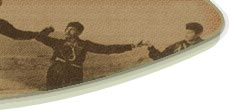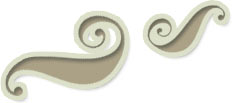|
 
:
Drosoulites
:
The Lyre Player
: Virgin Mary of Harakas
:
Legends of Fragokastelo
:
The Threshing Floor
A
little bit further of «Koumpedes» in Heraklion, in the feet
of Stroumpoulas, next to the old highway, in the 14th kilometre
to Rethimno, there is a big circular ditch known as the «Threshing
Floor».
This extraordinary settle was always causing the justified
curiosity of passerbies, because the place around is rough,
almost inhospitable, full of hard stones and a little dust.
At what time, therefore, they wonder, and for what reason
did this circular piece of ground settled down? And does its
name has any relation with what the word expresses or it is
owed only to its shape? The experts say that this was formed
by a collapse of an underground cavern, but people from the
around regions support that in this place really existed a
regular threshing floor that was lost with its owner.
That threshing floor, noone has ever seen it, but the tradition
does not allow any doubts.
In
the old times, Crete, thanks to its residents hard work, was
a bright green garden. And still today, where thorns and bushes
are all over the place, at that time, the diligence of the
Cretans made the ground to produce almost everything.
All those who walk along the Cretan countryside see today,
here and there, threshing floors in desert places, almost
razing, full of grass and earth, but it is certain that in
other times and particular during the summertime, they used
to present a completely other image.
A big threshing floor was there that today is the circular
settle. And as it used to happen everywhere, in the beginning
of each summertime its owner used to clean it, fix every damage
that had occured since last year and prepar it so as to work
for the new harvest. He was transfering in there the reaped
ears and the stacks would look as high towers. Then they would
thresh and carry in the house the fruit for the people and
the straw for the animals.
One year the harvest was so rich that even the most barren
fields fructified! The owner of the big threshing floor was
anxious whether he would have the time to thresh so many strewn,
to carry the straw and the fruit in his house? The weather
was very good, but since when? But how could not be in a hurry,
when a sudden cloudburst could destroy the hard work of an
entire year? Justified, therefore, the owner would put the
oxen in the threshing floor earlier than usual and finish
when the sun would set.
With
such hastiness the day of Prophet Helias came soon. A big
day, festive one. No one should be working. The big prophet
should be honoured. But the owner of the big threshing floor
could not lose an entire day.
-" We will go to the threshing floor!", he said
to his wife and daughter, with a tone in his voice that did
not raise any objection.
- "Today? The Saint will set fire on us!", the wife
dared to say.
- "The Saints have other work to do", he said back,
and forced them to go to the threshing floor with him.
Those
years the agricultural or stock-farming life was depending
mainly on the wheather. If it was drought, cold in spring,
if there were floods etc. the harvest could be destroyed and
people could be hungry. Thus, our ancestors, as they could
not face nature with their own forces, they turned to the
superior force, God. They became pious, they upholded with
fastidiousness all the things that the Church and the common
conscience was saying and they hoped that with all this they
would have the help «from the above» .
During the «skolades», the big feasts, they should not work
in no way, because the Saints didn't want to. There were though
certain days of peak, as we would call it today, for the agricultural
work. Such were the days of the harvest and vintage. The work
should be done fast, because with a sudden cloudburst, they
could lose the work and the hopes of a year. So, in some of
these days, they did not observe the religious holidays, as
they used to do the rest of the time.
But let's go back to our story: When they reached the thresing
floor, the owner and his wife yoked the oxen, and they begun
to thresh with their only daughter. Her voice, singsong, echoed
all around: «All around and all the straw is theirs...»
They were making sheafs and lift the straw. No one was around.
- A day like this and we are working! the woman whispered
with sadness.
«All around and all the straw is theirs...» the girl started
again, however before she completes the couplet, a horrible
bang was heard. Frightened they looked around, but they did
not have the time to move. The threshing floor went down taking
them all, people and animals as well, to the bottomless depths
of the ground! The prophet punished hardly those who did not
respect his day!
Some people say that the owner was a priest and not only didn't
he officiate the holy day, he went to the threshing floor to
work... Who knows?
Each year, on the 20th of July the creak that the straw makes
is clearly heard, as they are mixed by the owner and his wife
and the song of the girl, «All around and all the straw is theirs...»
If you don't listen to it, those of you that you will go there,
it can be from the sound of the cars that sent away the old
sounds and all of this that the legends were bringing to the
heart and the ears of the people.
It might be our own heart that is not worthy listening to the
secret voices of the legends... |


|





